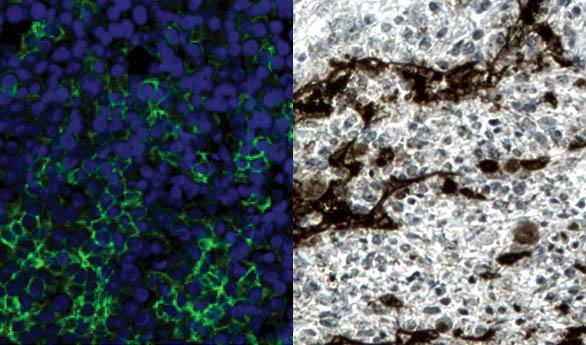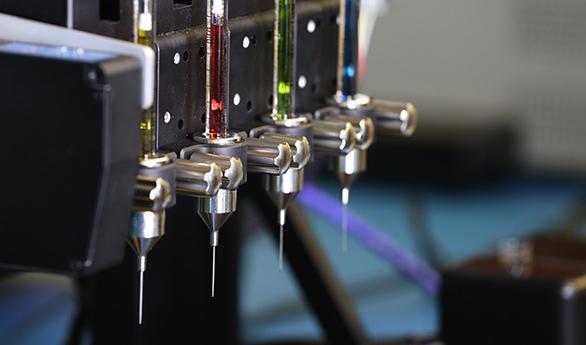 Perhaps the most exciting prospect of 3D printing technology for the medical industry, 3D bioprinting is poised to become a major innovation for the healthcare system. Forward-thinking medical companies like San Diego, California-based Organovo have fully dedicated themselves to designing and bioprinting functional human 3D tissues, an ambitious initiative that has helped them expand their company and cultivate an admirable reputation.
Perhaps the most exciting prospect of 3D printing technology for the medical industry, 3D bioprinting is poised to become a major innovation for the healthcare system. Forward-thinking medical companies like San Diego, California-based Organovo have fully dedicated themselves to designing and bioprinting functional human 3D tissues, an ambitious initiative that has helped them expand their company and cultivate an admirable reputation.
In fact, last year, Organovo reported a 209% revenue growth solely due to their 3D printed exVive3D liver tissue, and were later honored with Popular Science Magazine’s prestigious 2015 ‘Best of What’s New’ award for their bioprinted kidney tissue. Since the company’s promising developments of 2015 have started to come to fruition, Organovo has been on the up and up. Their subsidiary, Samsara Sciences, has positioned itself as a leading cell provider for their 3D bioprinting operations. The company has also been working to validate the use of their 3D printed human liver tissue in research, but their latest news takes Organovo’s innovation to a whole new level.
Today, Organovo has announced their plans to develop 3D bioprinted human liver tissues for direct transplantation to patients. The decision to begin this therapeutic tissue development program comes on the heels of their strong preclinical studies results in animal models, which have shown engraftment, vascularization, and sustained functionality of the bioprinted liver tissue. Organovo’s new program will focus on developing clinical solutions in two initial areas. The first is acute-on-chronic liver failure (ACLF), which is a distinct disease that leads to an acute deterioration of liver function for patients with liver disease. Secondly, Organovo will develop solutions for pediatric metabolic liver diseases, which represent another orphan disease indication where a bioprinted liver tissue patch may show therapeutic benefits.
“The scientific and commercial progress we have already made with ExViveTM Human Liver Tissue in drug toxicity testing has given us a firm foundation upon which to build a larger tissue for transplant,” said Keith Murphy, CEO, Organovo. “Advancing our first therapeutic tissue into preclinical development is an important milestone for Organovo, and it speaks to the power of our technology platform in addressing multiple applications, including preclinical safety, disease modeling and tissue replacement products for surgical implantation. We believe that 3D bioprinted tissues have an opportunity to provide options for patients who suffer from liver disorders.”
If the new initiative goes according to plan, in three to five years, Organovo will submit an Investigational New Drug (IND) application to the US Food and Drug Administration (FDA) for their therapeutic liver tissue. They also plan to implement their program in other countries as well, which will help accelerate the time to market. Today, at the 2016 Cell & Gene Meeting on the Mesa in La Jolla, Murphy will present the company’s bioprinted human liver as the first therapeutic tissue, and will continue to share future results at other conferences in the future.
In their preclinical trials, Organovo successfully delivered a patch of functional tissue directly to the liver, which proved to integrate well, remain on the liver, and maintain functionality as well. Using their breakthrough research, this innovative program could have a major impact on the lives of the 17,000 US patients currently on the liver transplant waiting list. Among all organs, the liver is the second highest transplant need, and supply has been the most constant difficulty in transplant medicine.
Though they’ve managed to get the farthest with their liver tissue research thus far, Organovo will continue to conduct research on other tissues for therapeutic use in direct transplants as well. These 3D bioprinted tissue patches could help greatly reduce the number of individuals stuck on a transplant list, or at the very least, extend their health for a few additional years before a full transplant is needed. All in all, thanks to the innovative research work and restless ambition of Organovo, the potential for functional 3D printed human tissue restoration has never seemed more possible. Discuss further in the 3D Printed Liver Tissue for Transplants forum over at 3DPB.com.
[Source: Organovo]Subscribe to Our Email Newsletter
Stay up-to-date on all the latest news from the 3D printing industry and receive information and offers from third party vendors.
Print Services
Upload your 3D Models and get them printed quickly and efficiently.
You May Also Like
Consolidation in AM: How 2025 Is Shaping the Industry’s New Normal
The first half of 2025 has been marked by a clear shift in the additive manufacturing (AM) industry. Companies are no longer just focused on developing new tech by themselves....
Etsy Design Rule Change Reduces Selection of 3D Printed Goods
Online marketplace Etsy has implemented a rule change requiring all 3D printed goods on the site to be original designs. The update to the site’s Creativity Standards states, ¨Items produced using...
U.S. Congress Calls Out 3D Printing in Proposal for Commercial Reserve Manufacturing Network
Last week, the U.S. House of Representatives’ Appropriations Committee moved the FY 2026 defense bill forward to the House floor. Included in the legislation is a $131 million proposal for...
Transforming From Tourist to Native: Duro CEO Michael Corr Explains Why the Company Rebuilt its PLM Software on AI
In these early innings of the AI boom, many market analysts have expressed concern that AI spend has gotten too far ahead of the technology’s proven ability to deliver significant...


































